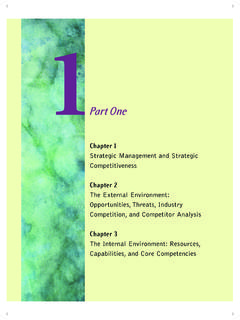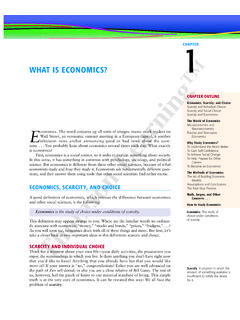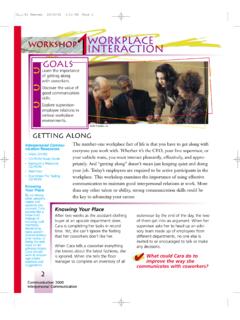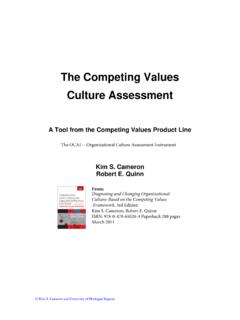Transcription of 8 Strategy Formulation and Implementation
1 ChapteRchapteRCHAPTER OUTLINET hinking StrategicallyWhat Is Strategic management ?Grand StrategyGlobal StrategyPurpose of StrategyLevels of StrategyThe Strategic ManagementProcessStrategy Formulation VersusImplementationSituation AnalysisFormulating Corporate-LevelStrategyPortfolio StrategyThe BCG MatrixFormulating Business-LevelStrategyPorter s Competitive Forces andStrategiesPartnership StrategiesFormulating Functional-LevelStrategyStrategy Implementation andControlLeadershipStructural DesignInformation and Control SystemsHuman ResourcesImplementing Global Strategies8 StrategyFormulation andImplementationLEARNING OBJECTIVESA fter studying this chapter, you should be able toDefine the components of strategic the strategic planning process and SWOT Grand Strategies for domestic and internationaloperationsDefine corporate-level strategies and explain the business-level strategies, including Porter scompetitive forces and strategies and partnership the major considerations in formulating the organizational dimensions used forimplementing might be the world s most powerfulbrand, but that has not helped much Douglas Daft took over as CEO of theCoca-Cola Company, he inherited a host oftroubles.
2 Soda sales had slumped in theimportant market and to a lesser extentaround the world, and Coke had failed tomatch rival Pepsi s aggressive moves intononsoda businesses. A high-profile racialdiscrimination suit in the United States anda soda-contamination scare overseas haddamaged the company s reputation and itsrelationships with customers, governments,and bottlers. Under the previous CEO, Ivester, there was no real sense ofcrisis at Coke s headquarters, where man-agers pretty much continued business asusual. The Australian-born Daft knew thatneeded to change if Coca-Cola was to remainone of the world s most admired andrespected companies. During his first year onthe job, Daft began dismantling the stale oldregime at headquarters and brought in newtop managers willing to make the toughchanges to turn the company around.
3 He alsospent much of his time repairing relationshipswith government regulators in Europe andhandling the backlash from financiallystrapped bottlers who charged that Coke hadbeen trying to eke out profits at the bottlers expense. Despite these early moves, Coke ssales and profits have stayed flat and the stockhas continued to decline. The CEO knows heneeds to come up with a powerful strategicplan to reignite the company in a you were the CEO of Coca-Cola, what strate-gies might you adopt to regain the competitiveedge? How would you go about formulating andimplementing a new strategic plan? management Challenge1 The story of Coca-Cola illustrates the importance of strategic planning. Cokehad been stumbling along for years, ever since the departure of belovedChairman and CEO Roberto Goizueta.
4 The late Goizueta had been a master atproviding vision and strategic direction for the company, but his hand-pickedsuccessor, Douglas Ivester, proved incapable of keeping Coke on the path ofsuccess. Now, employees, board members, and investors are hoping DouglasDaft can formulate and implement strategies that can ignite growth and revivethe troubled company. Every company is concerned with Strategy . Japan s Fuji Photo FilmCompany developed a Strategy of being a low-cost provider to compete withKodak. Fuji s relentless internal cost-cutting enabled the company to offercustomers lower prices and gradually gain market share over the giant devised a new Strategy of being a fierce product innovator tocompete with Mars in the candy scored big with the introduc-tion of such products as Twizzlers twisted licorice sticks, Jolly Rancher lol-lipops, and Bites, bite-sized pieces of favorite candy bars.
5 Strategic blunderscan hurt a company. Mattel suffered in recent years by losing sight of its corebusiness and trying to compete as a maker of computer games. New CEOR obert A. Eckert has implemented a back to basics Strategy that he hopeswill get the toymaker back on at Mattel, Hershey, Fuji, and Coca-Cola are all involved in strate-gic management . They are finding ways to respond to competitors, cope withdifficult environmental changes, meet changing customer needs, and effec-tively use available resources. Research has shown that strategic thinking andplanning positively affects a firm s performance and financial has taken on new importance in today s world of globalization, dereg-ulation, advancing technology, and changing demographics and are responsible for positioning their organizations for success in aworld that is constantly changing.
6 Today s top companies thrive by changingthe rules of an industry to their advantage or by creating entirely new example, Champion Enterprises was going broke selling inexpen-sive, factory-built houses. CEO Walter Young Jr. says, People thought we werein the trailer park business. It was a real perception problem. Young wanted toredraw the rules of the manufactured housing industry. Today, Champion isthriving by building full-size houses in its factories and offering customerssuch options as porches, skylights, and whirlpool this chapter, we focus on the topic of strategic management . First wedefine components of strategic management and then discuss a model of thestrategic management process.
7 Next we examine several models of strategyformulation. Finally, we discuss the tools managers use to implement theirstrategic 7 provided an overview of the types of goals and plans that organi-zations use. In this chapter, we will explore strategic management , which isconsidered one specific type of planning. Strategic planning in for-profitbusiness organizations typically pertains to competitive actions in the mar-ketplace. In not-for-profit organizations such as the Red Cross, strategicplanning pertains to events in the external environment. The final responsi-bility for Strategy rests with top managers and the chief executive. For anorganization to succeed, the CEO must be actively involved in making the2 CHAPTER 8 Strategy Formulation and ImplementationThinking Strategicallytough choices and trade-offs that define and support ,senior executives at such companies as General Electric, 3M, and Johnson& Johnson want middle- and low-level managers to think strategically.
8 Somecompanies also are finding ways to get front-line workers involved in strate-gic thinking and planning. Strategic thinking means to take the long-termview and to see the big picture, including the organization and the compet-itive environment, and to consider how they fit together. Understanding thestrategy concept, the levels of Strategy , and Strategy Formulation versusimplementation is an important start toward strategic Is Strategic management ?Strategic managementis the set of decisions and actions used to formulateand implement strategies that will provide a competitively superior fitbetween the organization and its environment so as to achieve Managers ask questions such as, What changes and trends are occur-ring in the competitive environment?
9 Who are our customers? What productsor services should we offer? How can we offer those products and servicesmost efficiently? Answers to these questions help managers make choicesabout how to position their organization in the environment with respect torival organizational performance is not a matter ofluck. It is determined by the choices that managers make. Top executives usestrategic management to define an overall direction for the organization,which is the firm s grand StrategyGrand strategyis the general plan of major action by which a firm intends toachieve its long-term strategies fall into three general cate-gories: growth, stability, and retrenchment. A separate grand Strategy can alsobe defined for global be promoted internally by investing in expansion orexternally by acquiring additional business divisions.
10 Internal growth caninclude development of new or changed products, such as Starbucks introduc-tion of Frappuccino, a bottled coffee drink, or expansion of current productsinto new markets, such as Avon s attempt to begin selling products in major retailstores. External growth typically involves diversification, which means the acqui-sition of businesses that are related to current product lines or that take the cor-poration into new areas. The number of companies choosing to grow throughmergers and acquisitions is astounding, as organizations strive to acquire the sizeand resources to compete on a global scale, to invest in new technology, and tocontrol distribution channels and guarantee access to markets. WorldCom, oncean obscure long-distance carrier, has acquired more than 40 companies in thepast decade and expanded into local phone services, data transmission, andInternet traffic.
















